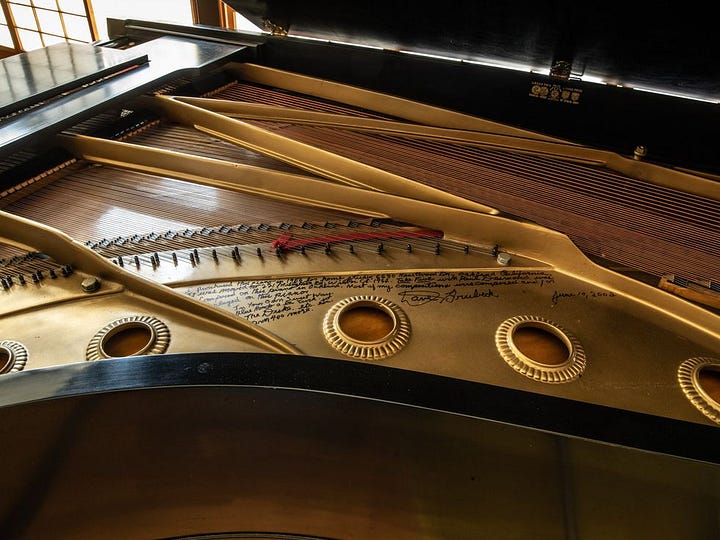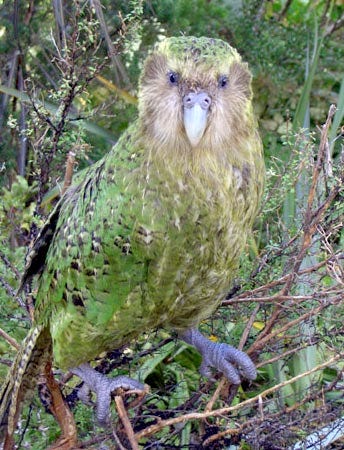Thing 1 – Pengwangs
A flightless bird is an odd thing. Flying is notoriously difficult, an ability for which most life forms on the planet would kill. And flightless birds just cast it aside like a squeezed out non-recyclable tube of toothpaste.
The reason for this is fairly straightforward: the ability to fly stopped being useful to them. But the trouble is that once you've got rid of it, it's a bugger to get back. And when circumstances change, that can leave you in a sticky situation.
Take the kākāpō.
My heart was won by the description and images of this bird – the world's only flightless parrot, found in just a very few areas of New Zealand – in Douglas Adams’ and Mark Carwardine’s Last Chance To See – the 1989 book and radio series tracking down species on the verge of extinction. (In an interview, Adams rated Last Chance To See as the “personal favourite” of his books.)
Dumpy, nocturnal and elusive, kākāpō are walkers, runners and climbers – that last endeavour helped by some surprisingly nifty beak-work – and their flightlessness wasn’t a problem for millions of years.
Then we came along.
They’d never had to deal with predators before, hence their flightlessness – a common occurrence in island species – so they simply saw no reason to run away from us. The poor fools. Our habit of hunting them and denuding their habitat was only exacerbated by the introduction of stoats and cats and so forth, which need no encouragement to kill a slow and – from the point of view of conservationists – exasperatingly trusting two-kilogram lump of feathered meat.
Flightlessness had served them well for ages – and then, suddenly, it was a disaster.
Another contributing factor to their descent into the ‘critically endangered’ list was their casual attitude to breeding, as described by Adams in this clip:
“It turns out that the mating habits of the kākāpō are incredibly long and drawn out, fantastically complicated, and almost entirely ineffective. People will tell you that the mating call of the male kākāpō actively repels the female.”
Kākāpō are doing better now. Still critically endangered, of course – it’ll be a while before they come off that list – but from a low of around 50 individual birds through the 1990s, they’ve recovered to a population of about 250 – a growth only enabled by concerted conservation efforts.
I would love to meet a kākāpō – a prospect that at the time of writing seems fairly remote – but for now I have to content myself with this clip of Mark Carwardine being shagged by one in the TV series of Last Chance To See (the follow-up Carwardine made with Stephen Fry twenty years after the original book and radio series).
If we find the kākāpō endearing – and we do, we really do – they have stiff competition in that department from penguins. And what with today being Penguin Awareness Day – it seems to come round quicker every year – what better way to mark the occasion than with a brief celebration of the magnificent piebald blubber tubes?
Of the sixty-odd – and they’re all pretty odd, frankly – flightless bird species on the planet, just under a third are penguins. And they are among our favourite birds. Perhaps it’s their posture – upright and dignified, their black-and-white colouring leading to comparisons with footmen or waiters; perhaps it’s that they’re so readily anthropomorphiseable; or perhaps it’s the magnificent sight of them launching themselves out of the water and onto the ice as if fired from a nerf gun.
The extraordinary underwater agility featured in that clip, so at odds with their clumsiness on the ground, owes a lot to their bones – solid, unlike those of most birds – and of course to the way they changed their air-friendly wings into powerful flippers well adapted to propelling them under water.
But playing an equally important role is their plumage. To survive in temperatures as low as minus forty, you need good insulation, and an Emperor penguin’s plumage provides exactly that. The outer layer, made up of short, overlapping contour feathers, is one thing. But underneath is where the magic really happens. Obviously the wodge of fat under the skin helps. But between the skin and the outer layer are two further kinds of feather – plumules and a kind of downy fluff known as “after-feathers” – which provide not just excellent insulation but a further benefit, which comes into its own when the penguins are underwater.
The plumules trap tiny air bubbles, giving the penguins excellent buoyancy, which is denuded when they’ve been under water for a while. So they go back up, have a bit of a preen to restore the buoyancy, dive down again and make their final launch run, leaving that dramatic trail of bubbles in their wake.
Isn’t (and I think I might have said this before) nature (or at least those bits of nature that aren’t us, even though we too have our moments of excellence) wonderful?
When I think of penguins, several things spring to mind. First is usually Werner Herzog’s nihilist penguin.
Next in line is obviously Benedict Cumberbatch and his famous inability to say the word ‘penguin’.
And then of course there’s this classic, fulfilling so many of the basic requirements for a viral internet hit.
Meanwhile, my inner three-year-old (never far from the surface) is always amused by Pingu.
And finally, may I recommend the Penguin Diplomacy episode from Series 2 of the peerless John Finnemore’s Double Acts? Unfortunately these excellent two-handers aren't on BBC Sounds at the moment, but there’s a taster of this episode here:
And if you're going to spend £8 on three hours of delicious entertainment that you will revisit time and time again, then I can think of nothing better. Series 1 is, to my mind, more even in quality (always high in any case), but the high points of Series 2 really are superb, and it’s worth getting for Julia McKenzie’s tour de force in “Mercy Dash” alone.
Thing 2 – Hydraulic Press Dance
I do not dance. Much like Gerry in Best In Show, I have two left feet.
But I do derive great pleasure from watching others do things skilfully that I can’t do myself (as anyone who has suffered my Strictly tweets every year will attest). And I particularly like it when dancers and choreographers get inventive. This manifestation, by the superb Smac McReanor, is particularly delicious.
Thing 3 – Swans Reunited
Sometimes a favourite clip resurfaces on social media and it’s a true delight. Here’s an example. A swan, rehabilitated after injury, being reunited with its partner. It’s so easy to anthropomorphise, but by any standards this is delightful.
The added bonus of this clip is that it was first shared by Simon Ricketts, who did Twitter about as perfectly as it is possible to do Twitter. This is a difficult concept to explain to non-tweeters, but he was the embodiment of what can be so good about that much maligned place.
Simon died just after Christmas in 2018, and is still missed by all those fortunate enough to encounter him there – I can only imagine the hole he left in the lives of those who actually knew and loved him in real life.
So whenever this particular clip resurfaces it reminds me of him, which is all to the good.
Thing 4 – Dave Brubeck’s House
We might want to see inside the houses of famous people out of curiosity (OK, nosiness – call it what you like). But in the case of Dave Brubeck’s house, which sold for $2.5 million a couple of years ago, we want to see it because it is every bit as cool as you might hope and/or expect. I particularly like the signed piano.




Thanks to Tom Cox for drawing my attention to it.





Thing 5 – Car Crash
Thing 5 rather speaks for itself, but I’m particularly fond of the rather camp look he gives at about nine seconds, as if to say “Volvo drivers, what are they like?”
Thing 6 – Look! Look! A book!
Almost in passing, all casual, like – oh yes, I did this by the way – here is, in truth, the thing I’m most excited about right now (sorry pengwangs, sorry Smac, sorry swans, sorry Dave, sorry Volvo crash).
This book has been a couple of years in the making. Like the universe, the subject kept expanding, and there were times when it felt like an unfinishable project. But deadlines are deadlines, and after only a little more than the standard amount of whooshing, I did finally manage to write “THE END” (this isn’t quite true – as so often, the last thing I wrote wasn’t in fact the end but a much-procrastinated bit somewhere near the middle, but narrative satisfaction trumps truth any day.)
Taking Flight will be published on May 4th (I’m bracing myself for the inevitable onslaught of Star Wars jokes). You can, if you wish, pre-order it (I defend the word ‘pre-order’ because it carries with it the implication, absent in ‘order’ of “it's not actually available yet, but you can stake your claim for when it is”.)
We like pre-orders because they tell the universe – booksellers, the algorithm, the world in general – “here is a thing of interest”. Pre-orders make a book visible. It’s not right that there should be a ‘window’ for a book to inspire interest, but there it is. The window generally lasts a few months. Generating interest and, let’s face it, sales, isn’t absolutely essential in that window – books sometimes have resurgences at surprising times, often several years after first publication – but it sure helps. It’s easy to forget, when you’re creating things, that publishing is a business like any other, but it is, and a cruel and unpredictable one at that.
Incidentally, I was reminded, by the arrival of my PLR statement this week, of the power of borrowing. If you borrow a book from a library in the UK, the author gets a little bit of cash. The actual amount depends on a number of factors, but one thing seems clear: it’s more than we get when you buy the same book on Amazon.
Go figure.
So if £16.99 for a hardback is too much (and that’s perfectly understandable – it’s not an insignificant amount for what many would consider a small luxury) there are other options. And we will thank you for choosing that one.
Thanks for consuming. If you’ve enjoyed it, do tell a friend.
I welcome comments, too. No, really, I do.







